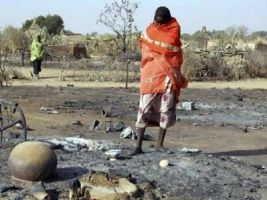WITNESS-Five years on, what good can reporting Darfur do?
By Opheera McDoom
February 25, 2008 (KHARTOUM) — An elderly Darfuri woman stood in front of the charred remains of her house. She tapped me on my shoulder and held out a wizened hand full of seeds.
 “How am I supposed to eat this?” she pleaded.
“How am I supposed to eat this?” she pleaded.
Totally humbled, I was speechless, unsure how to help.
Now her face haunts my nightmares.
It will be five years on Tuesday since war broke out in Darfur, since rebels seized a town and prompted a Sudanese counter-insurgency reckoned by foreign experts to have killed 200,000 people and driven 2.5 million from their homes.
I have been writing on Darfur for 4 1/2 years.
More than ever, I am wondering how much difference my reporting can make.
Despite the world’s largest aid operation and global media attention, people are still dying, foreign peacekeepers have not been fully deployed and the woman in my nightmares cannot eat.
Camps housing villagers driven from their homes have become semi-permanent — massive, chaotic suburbs of major towns where tensions can explode at any moment.
Darfuris seek to return to their farms, but fear the militiamen riding in on horses or camels.
Far from getting nearer to a solution as time goes on, the Darfur conflict seems to get ever more complicated.
The war is entwined with another in neighbouring Chad. Rebel factions have fragmented beyond recognition and Arab tribes have turned on the government that mobilised them.
Armed groups tear through towns in unmarked camouflaged vehicles carrying heavy weapons. Ragged fighters hang off the sides. No one knows who is who anymore.
The only law comes from the gun.
HOLLYWOOD
It is not that the outside world is not interested. Envoy after envoy comes to visit and so do the Hollywood stars.
It can seem almost comical when I try to explain to fighters or displaced villagers who was the latest superstar to put in a brief appearance.
Although the fighting is not as heavy as before, the conflict has destroyed a way of life. Everyone has a story of crime and lawlessness in a land where visitors could once feel secure despite the poverty.
A taxi driver broke down in tears as he lifted his cap to show me the scars of an attack.
One of my government contacts was shot dead by a car thief inside the ministry compound of el-Fasher, Darfur’s main town.
I came face to face with militias known as Janjaweed — a name now synonymous with “bogeyman” — when filming the destruction after a government bombing raid.
As a horsemen pulled out his rifle, I followed the lead of the Darfuris, zigzagging terrified to an abandoned hut.
We could hear shooting as we crouched petrified inside.
Frantically, I whispered down the satellite telephone line to call for help from peacekeepers from a United Nations-African Union force.
Luckily for me they came, and I suffered only half an hour of the terror that the people of Darfur endure daily.
Darfuris hope the biggest U.N.-funded peacekeeping force will soon be able to deploy across their region, to bring a measure of peace they have dreamed of for years.
The force’s African commanders say they are ready to start moving out if only the international community can send the equipment and reinforcements they need.
But the signs are not all promising and deployment has also been delayed by wrangling over the force’s composition.
Meanwhile, fighting has intensified in West Darfur as the government tries to drive rebels from their strongholds.
And the hopes for the force are starting to give way again to doubts over whether the nightmares will ever end.
(Reuters)
